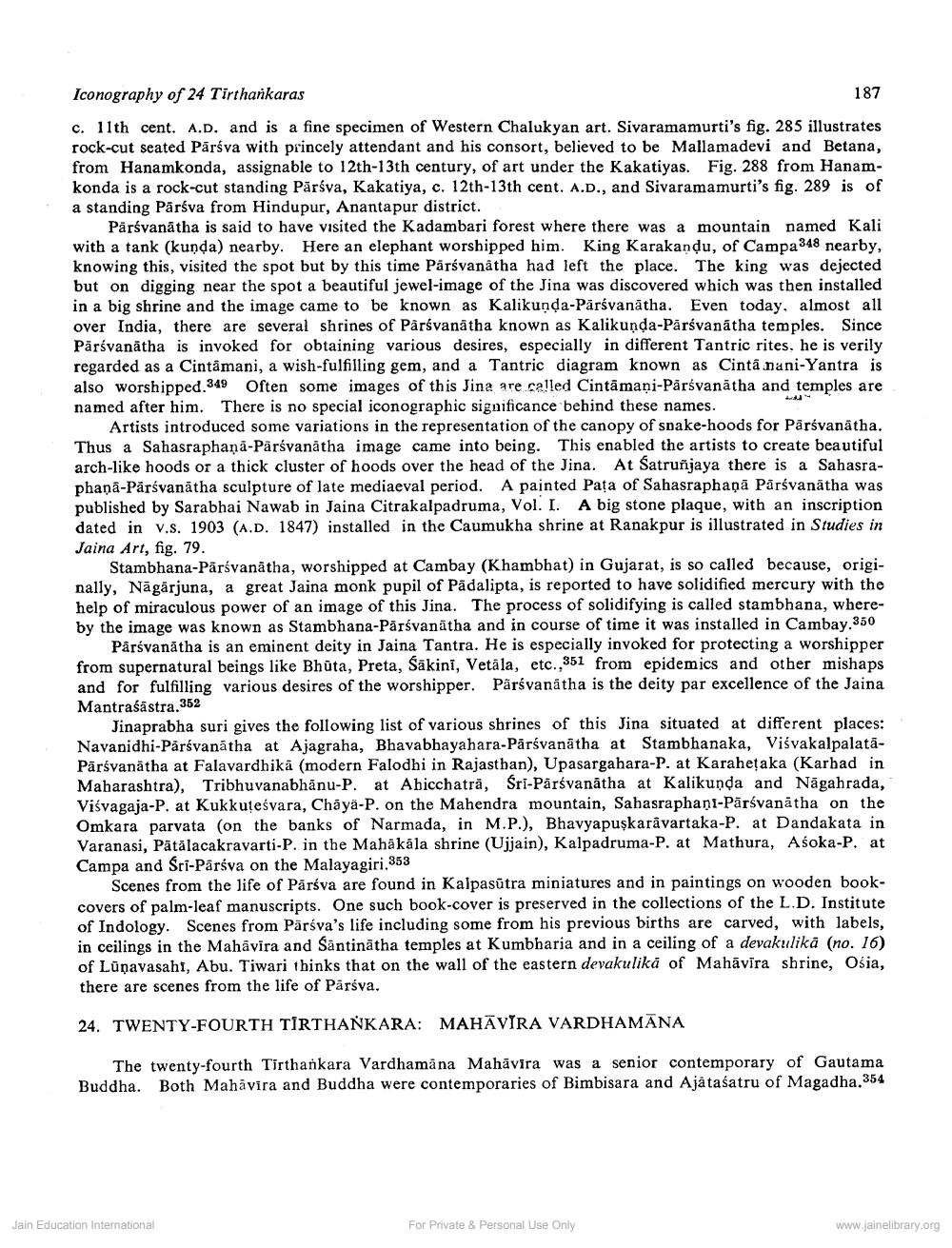________________
Iconography of 24 Tirtharkaras
187
c. 11th cent. A.D. and is a fine specimen of Western Chalukyan art. Sivaramamurti's fig. 285 illustrates rock-cut seated Pārsva with princely attendant and his consort, believed to be Mallamadevi and Betana, from Hanamkonda, assignable to 12th-13th century, of art under the Kakatiyas. Fig. 288 from Hanamkonda is a rock-cut standing Pārsva, Kakatiya, c. 12th-13th cent. A.D., and Sivaramamurti's fig. 289 is of a standing Pārsva from Hindupur, Anantapur district.
Pārsvanātha is said to have visited the Kadambari forest where there was a mountain named Kali with a tank (kunda) nearby. Here an elephant worshipped him. King Karakandu, of Campa 348 nearby, knowing this, visited the spot but by this time Pasívanátha had left the place. The king was dejected but on digging near the spot a beautiful jewel-image of the Jina was discovered which was then installed in a big shrine and the image came to be known as Kalikunda-Pärsvanatha. Even today, almost all over India, there are several shrines of Pārsvanātha known as Kalikunda-Pärsvanatha temples. Since Pārsvanātha is invoked for obtaining various desires, especially in different Tantric rites, he is verily regarded as a Cintamani, a wish-fulfilling gem, and a Tantric diagram known as Cinta nani-Yantra is also worshipped.349 Often some images of this Jina are called Cintamani-Pärsvanatha and temples are named after him. There is no special iconographic significance behind these names.
Artists introduced some variations in the representation of the canopy of snake-hoods for Pārsvanātha. Thus a Sahasraphaņā-Pārsvanātha image came into being. This enabled the artists to create beautiful arch-like hoods or a thick cluster of hoods over the head of the Jina. At Satruñjaya there is a Sahasraphana-Pärśvanātha sculpture of late mediaeval period. A painted Pața of Sahasraphaņā Pārsvanātha was published by Sarabhai Nawab in Jaina Citrakalpadruma, Vol. I. A big stone plaque, with an inscription dated in V.S. 1903 (A.D. 1847) installed in the Caumukha shrine at Ranakpur is illustrated in Studies in Jaina Art, fig. 79.
Stambhana-Pärsvanatha, worshipped at Cambay (Khambhat) in Gujarat, is so called because, originally, Nāgärjuna, a great Jaina monk pupil of Padalipta, is reported to have solidified mercury with the help of miraculous power of an image of this Jina. The process of solidifying is called stambhana, whereby the image was known as Stambhana-Pärsvanātha and in course of time it was installed in Cambay.350
Pårśvanātha is an eminent deity in Jaina Tantra. He is especially invoked for protecting a worshipper from supernatural beings like Bhuta, Preta, Säkini, Vetāla, etc.,351 from epidemics and other mishaps and for fulfilling various desires of the worshipper. Pārsvanatha is the deity par excellence of the Jaina Mantraśāstra 352
Jinaprabha suri gives the following list of various shrines of this Jina situated at different places: Navanidhi-Pärsvanātha at Ajagraha, Bhavabhayahara-Pārsvanatha at Stambhanaka, Viśvakalpalatā. Pārsvanātha at Falavardhika (modern Falodhi in Rajasthan), Upasargahara-P. at Karahetaka (Karbad in Maharashtra), Tribhuvanabhānu-P. at Abicchatrā, Śri-Pārsvanātha at Kalikunda and Nāgahrada, Viśvagaja-P. at Kukkuteśvara, Chaya-P. on the Mahendra mountain, Sahasraphani-Pārsvanatha on the Omkara parvata (on the banks of Narmada, in M.P.), Bhavyapuskaråvartaka-P. at Dandakata in Varanasi, Pātālacakravarti-P. in the Mahakāla shrine (Ujjain), Kalpadruma-P. at Mathura, Asoka-P. at Campa and Sri-Päráva on the Malayagiri 353
Scenes from the life of Pārśva are found in Kalpasūtra miniatures and in paintings on wooden bookcovers of palm-leaf manuscripts. One such book-cover is preserved in the collections of the L.D. Institute of Indology. Scenes from Pārsva's life including some from his previous births are carved, with labels, in ceilings in the Mahavira and Santinätha temples at Kumbharia and in a ceiling of a devakulikå (no. 16) of Lūpavasahi, Abu. Tiwari thinks that on the wall of the eastern devakulikā of Mahāvīra shrine, Ośia, there are scenes from the life of Parsva.
24. TWENTY-FOURTH TIRTHANKARA: MAHĀVIRA VARDHAMANA
The twenty-fourth Tirthankara Vardhamana Mahāvira was a senior contemporary of Gautama Buddha. Both Mahavira and Buddha were contemporaries of Bimbisara and Aja taśatru of Magadha.354
Jain Education International
ional
For Private & Personal Use Only
www.jainelibrary.org




